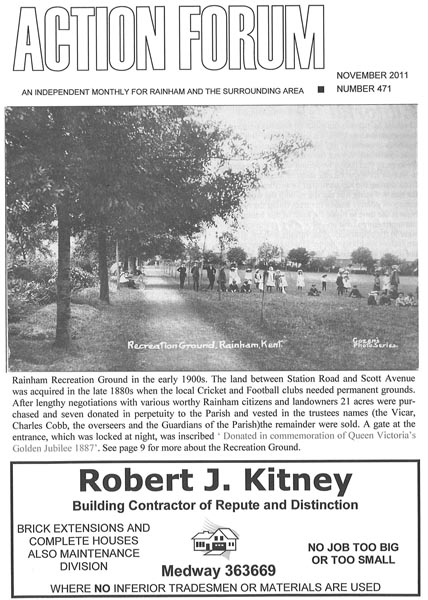Demand for a recreation ground increased during the late1880s because there wasn't a suitable place for people to play sport or to enjoy general recreation and the newly amalgamated Rainham Football and Cricket Club wanted a permanent venue. Something needed to be done to provide this.
During the second half of the 19th century people could wander into ...Berengrove Park which stretched almost to Rainham railway station with attractive woodland, ponds and a large paddock. The Walter family who lived in Berengrove House and who owned the area allowed events like the Rainham Flower Show and fetes to take place and even allowed Rainham Cricket Club to play periodic matches there but not on a permanent basis.

The problem of a recreation ground was finally solved in 1888-89 when Lord Hothfield who owned a large part of Rainham presented the village with a seven acre field between the present Station Road and Scott Avenue in celebration of Queen Victoria’s Jubilee. This became known as Rainham Recreation Ground. Before this the land had been rented to a Rainham based tenant farmer named Mr Prentis for agricultural use.
On March 27th 1887 the Rainham Parish Council appointed a committee to find a suitable site for a recreation ground. The search lasted for almost a year then they accepted Lord Hothfield’s offer on a site between the present Station Road and Scott Avenue.
On April 26th 1888 Lord Hothfield sent a letter to the parish council giving them the option of the ground on a 21 year lease or to purchase the ground directly from Mr Prentis the tenant farmer. This resulted in Mr J. Quinnel, a member of the parish council, offering to buy the area consisting of 21 acres then let the Parish Council have the seven acres required for the recreation ground.
Although the field was valued at £1,700 Lord Hothfield accepted £1,550 and offered to donate the difference of £150 as a subscription to the Rainham Football & Cricket Club. However, a problem then arose as Mr Prentis, the tenant farmer, demanded £5 per acre. Mr Quinnel would only offer £2/10/0 or come to an agreement based upon a valuation of the ground. Mr Prentis wouldn't accept this so Mr Quinnel backed out of the deal.
Marshall Harvey, accountant for Wakeley Brothers then took over the matter and established a company on behalf of the parish for the purchase of 21 acres. After the purchase seven acres were then handed over to the parish council and the remainder sold. The ground was then vested in the trustees, consisting of the vicar Reverend Charles Cobb, the overseers and the Guardians of the Parish.
The deeds gave the parish the seven acres in perpetuity, to be fenced off and vested in the trustee’s name. The parish council proposed that the ground should be used for general recreation but the cricket club was reserved one acre of ground at the Scott Avenue end of the field while the football club used the other end. Firstly clover was planted on the ground then the bottom half was turfed for cricket. Trees were later planted, flower beds were laid and a bicycle track established around the playing area.
A committee oversaw the ground and this became known as the Rainham Recreation Ground Committee. This consisted of Mr R.M. Wakeley, Mr Jelly, Mr Charlesworth, Mr Brice, Mr Filmer, Mr Hunt and Mr Morgan who were all members of the cricket club.
After more than a decade without their own ground and a series of short-term arrangements Rainham Cricket club began the new decade with their first season at their new venue in 1890. The football club started playing football there the following winter.
The Cricket Square, situated at the Scott Avenue end of the recreation ground was laid and prepared during the winter months of 1889-1890. The Reverend J A Walter, Mr. J Stewart, Mr. J Quinnel, Mr. S Brice and Mr. R.M. Wakeley contributed turf and Ernie Morgan, the landlord of the White Horse Inn, carted it to the ground. Meanwhile, the recreation ground was fenced in at a cost of £130/2/8d and paid by the Rainham Recreation Ground Committee.
According to a report in the “East Kent Gazette,” dated November 1890 turfing was completed in the early part of 1890. The Rainham Football & Cricket Club believed that they had a good ground and it would be properly looked after. Therefore, the problem of a permanent ground was finally resolved.
During the early twentieth century a caretaker looked after playing area, a water pipe was installed so that the cricket square could be watered in 1904 and public toilets were erected at the Scott Avenue end of the ground. A wooden structure was also built on the Wakeley road side of the ground with a central open space for the storage of equipment. This structure remained on the ground until the 1980s.
Although a caretaker oversaw the ground boys playing football on the cricket square became problematic. In 1906 two boys named Silas Apps and Henry Wills were repeatedly caught playing there after several warnings. The caretaker reported them to the Rainham Recreation Ground Committee who then wrote letters warning their parents and threatening prosecution unless it stopped.
Finally, with the recreation ground set up a permanent venue for football, cricket, general recreation, fetes and the Rainham Flower Show existed. Rainham Cricket Club moved permanently away to Berengrove Park in 1923 but Rainham Football Club continued to play there until the 1980s. Today the area continues to exist for recreational purposes although changes with a children’s play area, a brick built pavilion, basketball facilities and a footpath that stretches across the area have become established since the 1980s.
